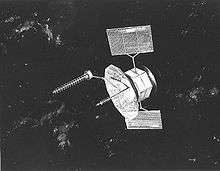Fleet Satellite Communications System

FLTSATCOM (also FLTSAT) was a satellite communication system of the U.S. Navy which was used for UHF radio communications between ships, submarines, airplanes and ground stations of the Navy.
Most of the transponders on these satellites were simple repeaters with no authentication or control over what they retransmitted. This characteristic led to a subculture of radio pirates in Brazil using modified ham radio equipment to use the satellites without authorization.
Altogether eight satellites were launched from 1978 to 1989 by Atlas-Centaur rockets into geostationary orbit. The system became operational in 1981. The satellites were manufactured by TRW. The solar arrays of the satellites had a span of over 13.2 m. A special characteristic was an UHF transmit antenna reflector 4.9 m in diameter. The satellites had 12 transponders, which worked in the UHF range from 240 - 400 megahertz. Additionally FLTSATCOM 7 and 8 had an experimental EHF transponder built by Lincoln Laboratory intended to test the MILSTAR ground terminals. The first seven satellites had a launch mass of 1884 kg and the remaining two were 2310 kg, with the additional mass due to the EHF payload module.
The fifth satellite reached geosynchronous orbit, but was unusable due to damage to the solar arrays and antennas. The failure was attributed to explosive delamination of the fiberglass honeycomb fairing during flight. The inside wall of the fairing extensively damaged one of the solar arrays, and bent the transmit antenna mast which prevented the antenna from deploying fully.
Flight 7 was launched out of sequence after a launch failure of a Delta mission carrying the GOES-G weather satellite grounded the entire US launch fleet weeks prior to the scheduled launch of F-6. By the time the Delta mishap investigation concluded there was no risk to the Atlas-Centaur system, F-7 was ready to launch and the system managers elected to swap missions to avoid delaying EHF system testing.
Flight 6 was destroyed in one of the US space program's more notorious accidents. The Atlas-Centaur was launched on March 26, 1987 into a pouring Florida thunderstorm. At about 30 seconds into the flight, the Atlas was struck by lightning and the resulting static discharge sent an erroneous signal to the guidance computer, causing it to pitch over and break apart from structural stress. The booster exploded and showered burning debris onto LC-36B, which was barely visible through the heavy rain. As a result of this easily preventable disaster, NASA issued strict weather guidelines for all launches.
In the late 1990s, FLTSATCOM satellites were gradually replaced by the UFO satellites. FLTSAT flights 7 and 8 continue to provide UHF communications.
Launches
| Satellite | Launch | Rocket | Note |
|---|---|---|---|
| FLTSATCOM 1 | February 9, 1978 | Atlas-SLV3D Centaur-D1AR | Success |
| FLTSATCOM 2 | May 4, 1979 | Atlas-SLV3D Centaur-D1AR | Success |
| FLTSATCOM 3 | January 18, 1980 | Atlas-SLV3D Centaur-D1AR | Success |
| FLTSATCOM 4 | 31. October 31, 1980 | Atlas-SLV3D Centaur-D1AR | Success |
| FLTSATCOM 5 | August 6, 1981 | Atlas-SLV3D Centaur-D1AR | Damaged upon launch |
| FLTSATCOM 7 | December 5, 1986 | Atlas-G Centaur-D1AR | Success |
| FLTSATCOM 6 | March 27, 1987 | Atlas-G Centaur-D1AR | Lightning strike destroyed the rocket |
| FLTSATCOM 8 | September 25, 1989 | Atlas-G Centaur-D1AR | Success |
See also
References
- Globalsecurity.org
- QuickLooks from NASA's Mission and Spacecraft Library
- Federation of American Scientists - FLTSATCOM System
- FLTSATCOM Flight 6 Launch Book - TRW Electronics and Defense Sector, April 1986